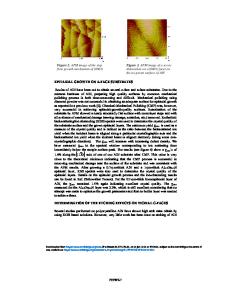Fabrication and characterization of aluminum nitride sponges using a mixture of two porous formation methods
- PDF / 1,616,831 Bytes
- 11 Pages / 432 x 648 pts Page_size
- 86 Downloads / 325 Views
MRS Advances © 2019 Materials Research Society DOI: 10.1557/adv.2019.408
Fabrication and characterization of aluminum nitride sponges using a mixture of two porous formation methods Rodrigo Alan Martínez Molina1, José Egberto Bedolla Becerril1, Ena Athenea Aguilar Reyes1,
Raul Alejando Pulido Aguilar1, Carlos Arreola Fernandez1
1
Universidad Michoacana de San Nicolás de Hidalgo, Instituto de Investigación en Metalurgia y Materiales, Mexico.
ABSTRACT
A method for the fabrication of interconnected ceramic sponges was used in the present work, designed by using a combination of two different, aqueous gel casting and sacrificial template, using aluminum nitride powder (99.97%) with a mean size of 2.4 micrometers. Two types of sponges were made by using two different monomers, acrylamide and methacrylamide, the resultants sponges have 60% of porosity after being sintered and pyrolyzed at temperature of 1673 K using an inert atmosphere of argon for 1 h. The hydrolysis evolution of this ceramic powder during the gelcasting process was studied by measuring the pH during the stirring time, the microstructure changes during the time of exposure were observed in a SEM. XRD were made to study the present phases after the gel was eliminated by thermal treatment at 873 K using an oxidizing atmosphere, observing a formation of up to 4 %wt. of cubic alumina phase which was made after the hydrolysis products. Infrared spectroscopy was used to study the changes in the ceramic powder.
INTRODUCTION At present, ceramic sponges made by different methods have the disadvantages of high distribution of the pore size, since the pores vary too much in size and shape [1,2], for this kind of problem there are various solutions. Depending on the type of foam that is to be obtained in a final way, there are direct foaming methods that generate pores in a more controlled manner [3–5], these methods have the disadvantage that the final
Downloaded from https://www.cambridge.org/core. Karolinska Institutet University Library, on 12 Jan 2020 at 06:01:18, subject to the Cambridge Core terms of use, available at https://www.cambridge.org/core/terms. https://doi.org/10.1557/adv.2019.408
result may not have a porosity completely interconnected, due to the bubbles formation of the used gas that are trapped after sintering. Ceramic 3D printing processes are derived in two categories, those that use a polymer with ceramic particles in it, and those that use ceramic powders to printing [6, 7], the first category solves the initial problem, since it generates a controlled porosity by the design during printing, and a smaller porosity that cannot be controlled, due to the space left by the polymer after being consumed, in addition this is a process of a high price currently [8, 9]. The second, although avoids this main problem, it is more expensive, in addition to ceramics that are susceptible to decomposing at sintering temperatures in an open furnace, a controlled atmosphere is required in the printing chamber, which makes this process even more ex
Data Loading...










